A Hybrid Multi-Objective Optimization Model for Vibration Tendency Prediction of Hydropower Generators
Abstract
1. Introduction
2. Proposed Predicting Model and Framework
2.1. Data Preprocess
2.1.1. Empirical Wavelet Transform (EWT)
2.1.2. AEWT Based on Sample Entropy Theory
2.2. Feature Selection
2.3. Kernel Extreme Learning Machine (KELM)
2.4. Multi-Objective Optimization
2.4.1. Multi-Objective Salp Swarm Algorithm (MOSSA)
| Algorithm 1: MOSSA | |
| Parameters: | |
| iter_max—The maximum number of iterations | lb—Variables lower bound |
| obj_no—Number of objective functions | ub—Variables upper bound |
| dim—Number of decision variables | N—The salp population |
| archive_maxsize—The maximum number of archive | |
| /* Set the parameters of MOSSA*/ | |
| /* Initialize the salp population considering ub and lb*/ | |
| while (iter < iter_max) do | |
| /* Calculate the objective values for each salp *//* Determine the non-dominated salps */ | |
| /* Update repository with the obtained non-dominated salps */ | |
| if (the repository becomes full) then | |
| /* Remove the repository resident by calling the repository maintenance procedure*/ | |
| /* Add the non-dominated salp to the repository */ | |
| end if | |
| /* choose the food source: F = Select Food (repository) */ | |
| update c1 | |
| for each salp (i = 1 to N) do if (i = = 1) then | |
| update the position of the leading salp | |
| else if () then | |
| update the position of the follower salp | |
| end if | |
| end for | |
| /* Adjuse the salps considering the ub and lb */ | |
| end while | |
| /* Return repository */ | |
2.4.2. Optimization Strategy
2.4.3. The Fitness Function
2.5. Evaluation Criterion
3. Engineering Application and Analysis
3.1. Data Collection
3.2. Model Description
3.3. Vibration Tendency Prediction of the HGU
3.3.1. Vibration Signal Decomposition and Mode Reconstruction
3.3.2. The Selection of the Best Compromise Solution
3.3.3. Analysis and Discussion
- (1)
- Compared with the other models of the first type, AEWT-KELM obtains better results than EEMD-KELM and EWT-KELM, which demonstrates that the SE-based reconstruction strategy can improve the forecasting precision.
- (2)
- Among the second type, AEWT-GSO-KELM performs better than AEWT-PCA-KELM, which indicates that GSO is more effective as a feature selection method in these experiments.
- (3)
- By comparing the first and second type models, i.e., AEWT-KELM vs. AEWT-GSO-KELM, we can conclude that the hybrid model integrating the GSO method enhances its performance in forecasting.
- (4)
- Compared with the SVR-based model, the KELM can realize a higher degree of forecasting, which suggests process that the ability of KELM is enhanced by the kernel function.
- (5)
- By comparing the final type models, it can be observed that the proposed model optimized by MOSSA performs better than that by MOPSO, which indicates MOSSA is superior to MOPSO in handling MOPs.
4. Conclusions
Author Contributions
Funding
Conflicts of Interest
References
- Zheng, Y.; Zhou, J.; Zhu, W.; Zhang, C.; Li, C.; Fu, W. Design of a multi-mode intelligent model predictive control strategy for hydroelectric generating unit. Neurocomputing 2016, 207, 287–299. [Google Scholar] [CrossRef]
- Xu, Y.; Zheng, Y.; Du, Y.; Yang, W.; Peng, X.; Li, C. Adaptive condition predictive-fuzzy PID optimal control of start-up process for pumped storage unit at low head area. Energy Convers. Manag. 2018, 177, 592–604. [Google Scholar] [CrossRef]
- Zhang, X.; Zhou, J.; Guo, J.; Zou, Q.; Huang, Z. Vibrant fault diagnosis for hydroelectric generator units with a new combination of rough sets and support vector machine. Expert Syst. Appl. 2012, 39, 2621–2628. [Google Scholar] [CrossRef]
- Fu, W.; Wang, K.; Li, C.; Li, X.; Li, Y.; Zhong, H. Vibration trend measurement for a hydropower generator based on optimal variational mode decomposition and an LSSVM improved with chaotic sine cosine algorithm optimization. Meas. Sci. Technol. 2018, 30, 015012. [Google Scholar] [CrossRef]
- Liu, J.; Hu, Y.; Wang, Y.; Wu, B.; Fan, J.; Hu, Z. An integrated multi-sensor fusion-based deep feature learning approach for rotating machinery diagnosis. Meas. Sci. Technol. 2018, 29, 055103. [Google Scholar] [CrossRef]
- Wang, Y.; Hu, Y.; Wu, B.; Liu, J. An integrated condition-monitoring method for a milling process using reduced decomposition features. Meas. Sci. Technol. 2017, 28, 085101. [Google Scholar]
- Hu, Z.; Wang, Y.; Ge, M.-F.; Liu, J. Data-driven Fault Diagnosis Method based on Compressed Sensing and Improved Multi-scale Network. IEEE Trans. Ind. Electron. 2019. [Google Scholar] [CrossRef]
- Xia, X.; Meng, Y.; Shi, B.; Qiu, M. Bootstrap Forecasting Method of Uncertainty for Rolling Bearing Vibration Performance Based on GM (1,1). J. Grey Syst. 2015, 27, 78–92. [Google Scholar]
- Dong, Y.; Zhang, Z.; Hong, W.-C. A Hybrid Seasonal Mechanism with a Chaotic Cuckoo Search Algorithm with a Support Vector Regression Model for Electric Load Forecasting. Energies 2018, 11, 1009. [Google Scholar] [CrossRef]
- Pham, H.T.; Yang, B.-S. Estimation and forecasting of machine health condition using ARMA/GARCH model. Mech. Syst. Signal Process. 2010, 24, 546–558. [Google Scholar] [CrossRef]
- Pavlovic, N.T.; Veg, A.; Troha, S.; Milovancevic, M.; Nikolic, V. Vibration prediction of pellet mills power transmission by artificial neural network. Assem. Autom. 2017, 37, 464–470. [Google Scholar]
- Fu, W.; Zhou, J.; Zhang, Y.; Zhu, W.; Xue, X.; Xu, Y. A state tendency measurement for a hydro-turbine generating unit based on aggregated EEMD and SVR. Meas. Sci. Technol. 2015, 26, 125008. [Google Scholar] [CrossRef]
- Javed, K.; Gouriveau, R.; Zerhouni, N.; Nectoux, P. Enabling Health Monitoring Approach Based on Vibration Data for Accurate Prognostics. IEEE Trans. Ind. Electron. 2015, 62, 647–656. [Google Scholar] [CrossRef]
- Fei, S.-W. Kurtosis forecasting of bearing vibration signal based on the hybrid model of empirical mode decomposition and RVM with artificial bee colony algorithm. Expert Syst. Appl. 2015, 42, 5011–5018. [Google Scholar] [CrossRef]
- Hong, W.-C.; Li, M.-W.; Geng, J.; Zhang, Y. Novel Chaotic Bat Algorithm for Forecasting Complex Motion of Floating Platforms. Appl. Math. Model. 2019, 72, 425–443. [Google Scholar] [CrossRef]
- Elsaid, A.; El Jamiy, F.; Higgins, J.; Wild, B.; Desell, T. Optimizing long short-term memory recurrent neural networks using ant colony optimization to predict turbine engine vibration. Appl. Soft Comput. 2018, 73, 969–991. [Google Scholar] [CrossRef]
- Fan, G.-F.; Peng, L.-L.; Hong, W.-C. Short term load forecasting based on phase space reconstruction algorithm and bi-square kernel regression model. Appl. Energy 2018, 224, 13–33. [Google Scholar] [CrossRef]
- Zhang, C.; Zhou, J.; Li, C.; Fu, W.; Peng, T. A compound structure of ELM based on feature selection and parameter optimization using hybrid backtracking search algorithm for wind speed forecasting. Energy Convers. Manag. 2017, 143, 360–376. [Google Scholar] [CrossRef]
- Chen, Z.; Wu, L.; Cheng, S.; Lin, P.; Wu, Y.; Lin, W. Intelligent fault diagnosis of photovoltaic arrays based on optimized kernel extreme learning machine and I-V characteristics. Appl. Energy 2017, 204, 912–931. [Google Scholar] [CrossRef]
- Vulli, S.; Dunne, J.; Potenza, R.; Richardson, D.; King, P. Time-frequency analysis of single-point engine-block vibration measurements for multiple excitation-event identification. J. Sound Vib. 2009, 321, 1129–1143. [Google Scholar] [CrossRef]
- Li, N.; Yang, J.; Zhou, R.; Wang, Q. Knock detection in spark ignition engines using a nonlinear wavelet transform of the engine cylinder head vibration signal. Meas. Sci. Technol. 2014, 25, 115002. [Google Scholar] [CrossRef]
- Huang, N.E.; Shen, Z.; Long, S.R.; Wu, M.C.; Shih, H.H.; Zheng, Q.; Yen, N.-C.; Tung, C.C.; Liu, H.H. The empirical mode decomposition and the Hilbert spectrum for nonlinear and non-stationary time series analysis. Proc. Soc. Lond. Ser. A Math. Phys. Eng. Sci. 1998, 454, 903–995. [Google Scholar] [CrossRef]
- Gilles, J. Empirical Wavelet Transform. IEEE Trans. Signal Process. 2013, 61, 3999–4010. [Google Scholar] [CrossRef]
- Liu, H.; Wu, H.; Li, Y. Smart wind speed forecasting using EWT decomposition, GWO evolutionary optimization, RELM learning and IEWT reconstruction. Energy Convers. Manag. 2018, 161, 266–283. [Google Scholar] [CrossRef]
- Hu, J.; Wang, J.; Ma, K. A hybrid technique for short-term wind speed prediction. Energy 2015, 81, 563–574. [Google Scholar] [CrossRef]
- Li, C.; Xiao, Z.; Xia, X.; Zou, W.; Zhang, C. A hybrid model based on synchronous optimisation for multi-step short-term wind speed forecasting. Appl. Energy 2018, 215, 131–144. [Google Scholar] [CrossRef]
- Ramsey, F.L. Characterization of the Partial Autocorrelation Function. Ann. Stat. 1974, 2, 1296–1301. [Google Scholar] [CrossRef]
- Polat, K.; Güneş, S. An expert system approach based on principal component analysis and adaptive neuro-fuzzy inference system to diagnosis of diabetes disease. Digit. Signal Process. 2007, 17, 702–710. [Google Scholar] [CrossRef]
- Abdoos, A.A. A new intelligent method based on combination of VMD and ELM for short term wind power forecasting. Neurocomputing 2016, 203, 111–120. [Google Scholar] [CrossRef]
- Xiao, L.; Shao, W.; Wang, C.; Zhang, K.; Lu, H. Research and application of a hybrid model based on multi-objective optimization for electrical load forecasting. Appl. Energy 2016, 180, 213–233. [Google Scholar] [CrossRef]
- Wang, J.; Heng, J.; Xiao, L.; Wang, C. Research and application of a combined model based on multi-objective optimization for multi-step ahead wind speed forecasting. Energy 2017, 125, 591–613. [Google Scholar] [CrossRef]
- Jiang, P.; Li, R.; Li, H. Multi-objective algorithm for the design of prediction intervals for wind power forecasting model. Appl. Math. Model. 2019, 67, 101–122. [Google Scholar] [CrossRef]
- Liu, Y.; Qin, H.; Mo, L.; Wang, Y.; Chen, D.; Pang, S.; Yin, X. Hierarchical Flood Operation Rules Optimization Using Multi-Objective Cultured Evolutionary Algorithm Based on Decomposition. Water Resour. Manag. 2019, 33, 337–354. [Google Scholar] [CrossRef]
- Galván, I.M.; Valls, J.M.; Cervantes, A.; Aler, R. Multi-objective evolutionary optimization of prediction intervals for solar energy forecasting with neural networks. Inf. Sci. 2017, 418, 363–382. [Google Scholar] [CrossRef]
- Mirjalili, S.; Gandomi, A.H.; Mirjalili, S.Z.; Saremi, S.; Faris, H.; Mirjalili, S.M. Salp Swarm Algorithm: A bio-inspired optimizer for engineering design problems. Adv. Eng. Softw. 2017, 114, 163–191. [Google Scholar] [CrossRef]
- Hu, Y.; Li, F.; Li, H.; Liu, C. An enhanced empirical wavelet transform for noisy and non-stationary signal processing. Digit. Signal Process. 2017, 60, 220–229. [Google Scholar] [CrossRef]
- Kedadouche, M.; Thomas, M.; Tahan, A. A comparative study between Empirical Wavelet Transforms and Empirical Mode Decomposition Methods: Application to bearing defect diagnosis. Mech. Syst. Signal Process. 2016, 81, 88–107. [Google Scholar] [CrossRef]
- Daubechies, I.; Heil, C. Ten Lectures on Wavelets. Comput. Phys. 1998, 6, 1671. [Google Scholar]
- Richman, J.S.; Lake, D.E.; Moorman, J.R. Sample Entropy. Methods Enzymol. 2004, 384, 172–184. [Google Scholar]
- Oussar, Y. Ranking a random feature for variable and feature selection. J. Mach. Learn. Res. 2003, 3, 1399–1414. [Google Scholar]
- Abdoos, A.A.; Mianaei, P.K.; Ghadikolaei, M.R. Combined VMD-SVM based feature selection method for classification of power quality events. Appl. Soft Comput. 2016, 38, 637–646. [Google Scholar] [CrossRef]
- Chen, H.-L.; Wang, G.; Ma, C.; Cai, Z.-N.; Liu, W.-B.; Wang, S.-J. An efficient hybrid kernel extreme learning machine approach for early diagnosis of Parkinson’s disease. Neurocomputing 2016, 184, 131–144. [Google Scholar] [CrossRef]
- Huang, G.-B.; Zhou, H.; Ding, X.; Zhang, R. Extreme Learning Machine for Regression and Multiclass Classification. IEEE Trans. Syst. Man Cybern. Part B 2012, 42, 513–529. [Google Scholar] [CrossRef]
- Lai, X.; Li, C.; Zhang, N.; Zhou, J. A multi-objective artificial sheep algorithm. Neural Comput. Appl. 2018, 1–35. [Google Scholar] [CrossRef]
- Zhang, C.; Peng, T.; Li, C.; Fu, W.; Xia, X.; Xue, X. Multiobjective Optimization of a Fractional-Order PID Controller for Pumped Turbine Governing System Using an Improved NSGA-III Algorithm under Multiworking Conditions. Complexity 2019, 2019, 1–18. [Google Scholar] [CrossRef]
- Zhou, J.; Xu, Y.; Zheng, Y.; Zhang, Y. Optimization of Guide Vane Closing Schemes of Pumped Storage Hydro Unit Using an Enhanced Multi-Objective Gravitational Search Algorithm. Energies 2017, 10, 911. [Google Scholar] [CrossRef]
- Abbassi, R.; Abbassi, A.; Heidari, A.A.; Mirjalili, S. An efficient salp swarm-inspired algorithm for parameters identification of photovoltaic cell models. Energy Convers. Manag. 2019, 179, 362–372. [Google Scholar] [CrossRef]
- Yang, X.-S. Bat Algorithm for Multi-objective Optimisation. Int. J. Bio-Inspired Comput. 2012, 3, 267–274. [Google Scholar] [CrossRef]
- Hyndman, R.J.; Koehler, A.B. Another look at measures of forecast accuracy. Int. J. Forecast. 2006, 22, 679–688. [Google Scholar] [CrossRef]
- BENTLY3300 Sensors. Available online: http://www.amy00.com/a/jszl/2017/63.html (accessed on 27 April 2019).
- Dhillon, J.; Parti, S.; Kothari, D. Stochastic economic emission load dispatch. Electr. Power Syst. Res. 1993, 26, 179–186. [Google Scholar] [CrossRef]


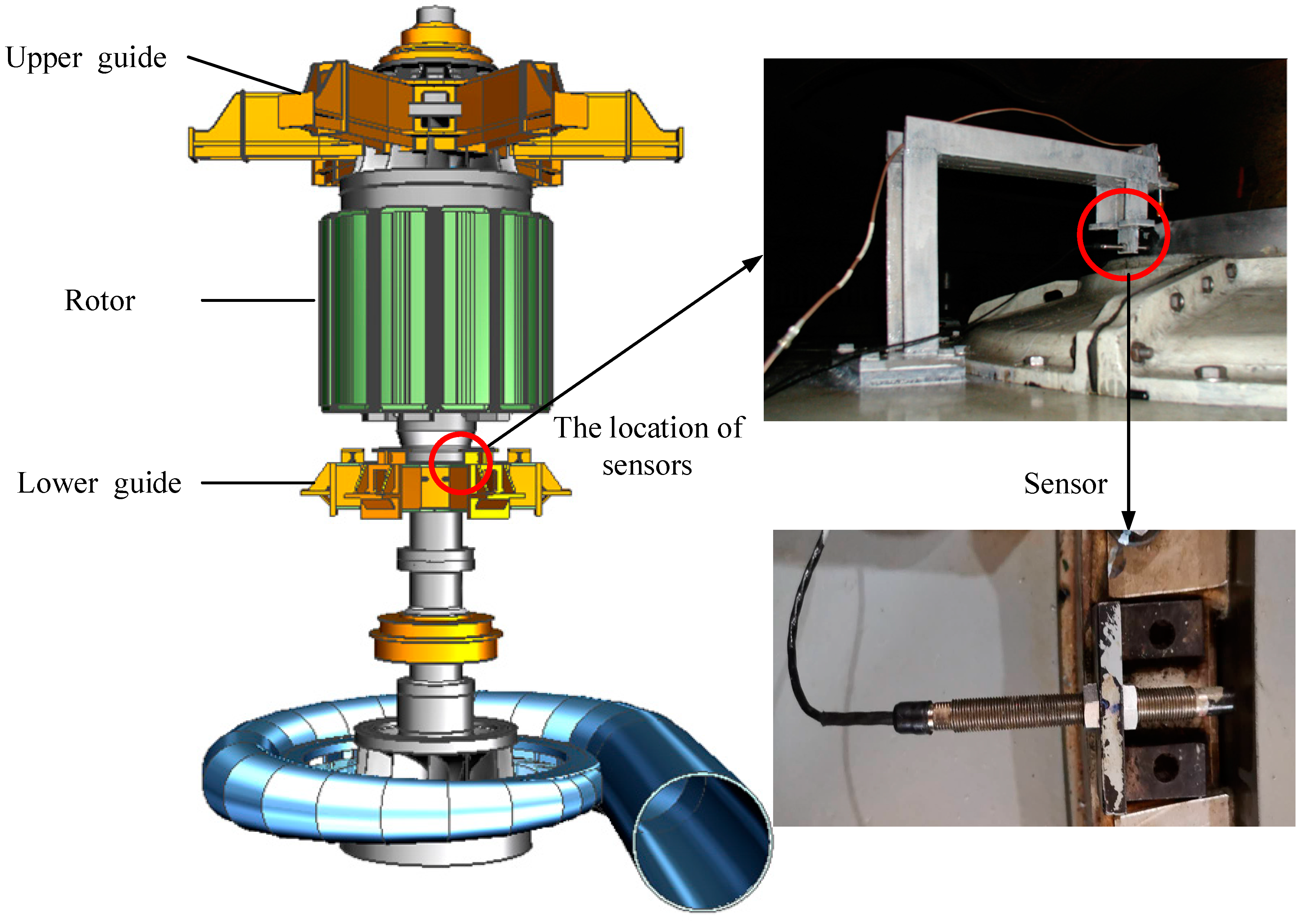
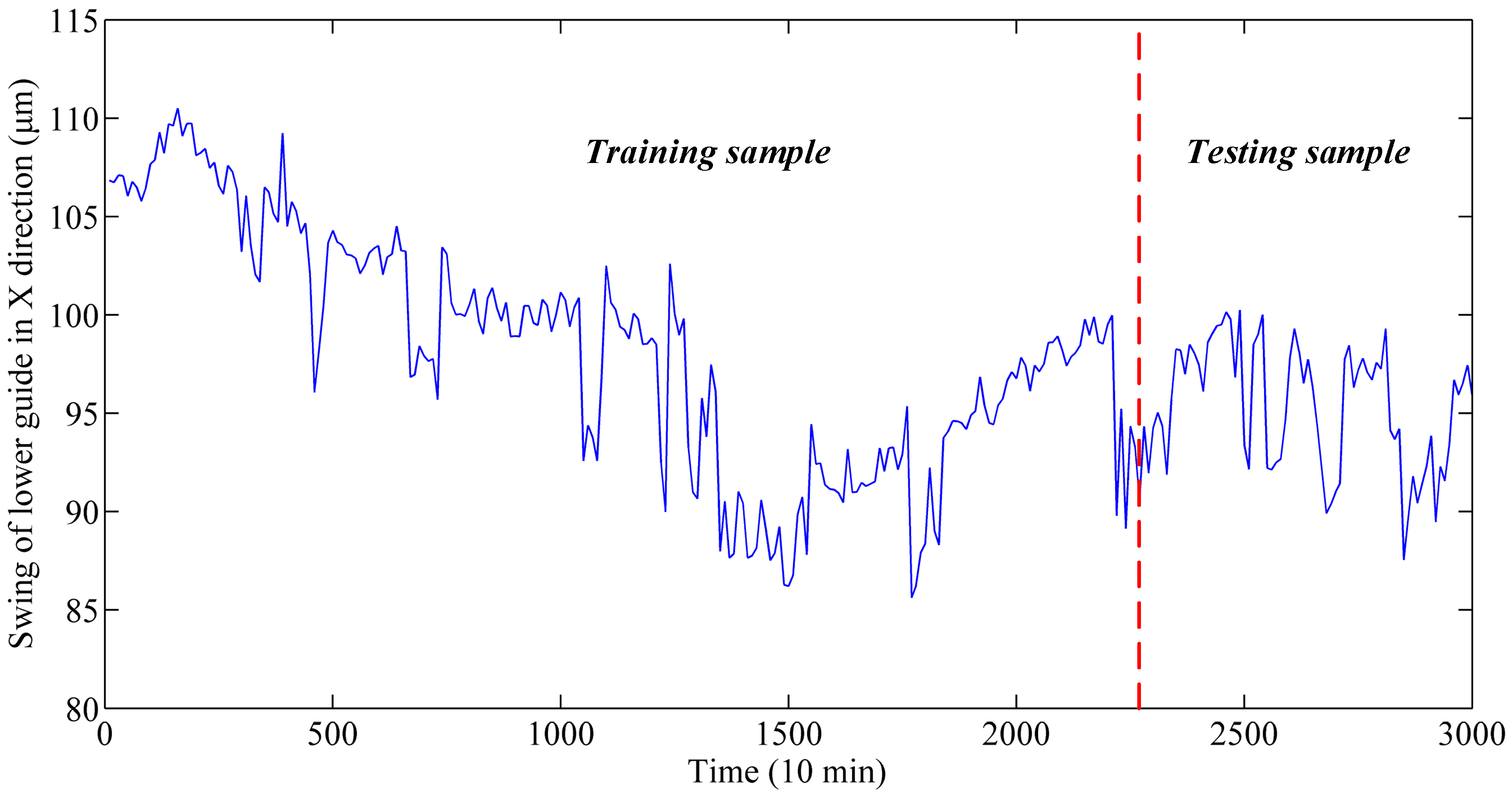
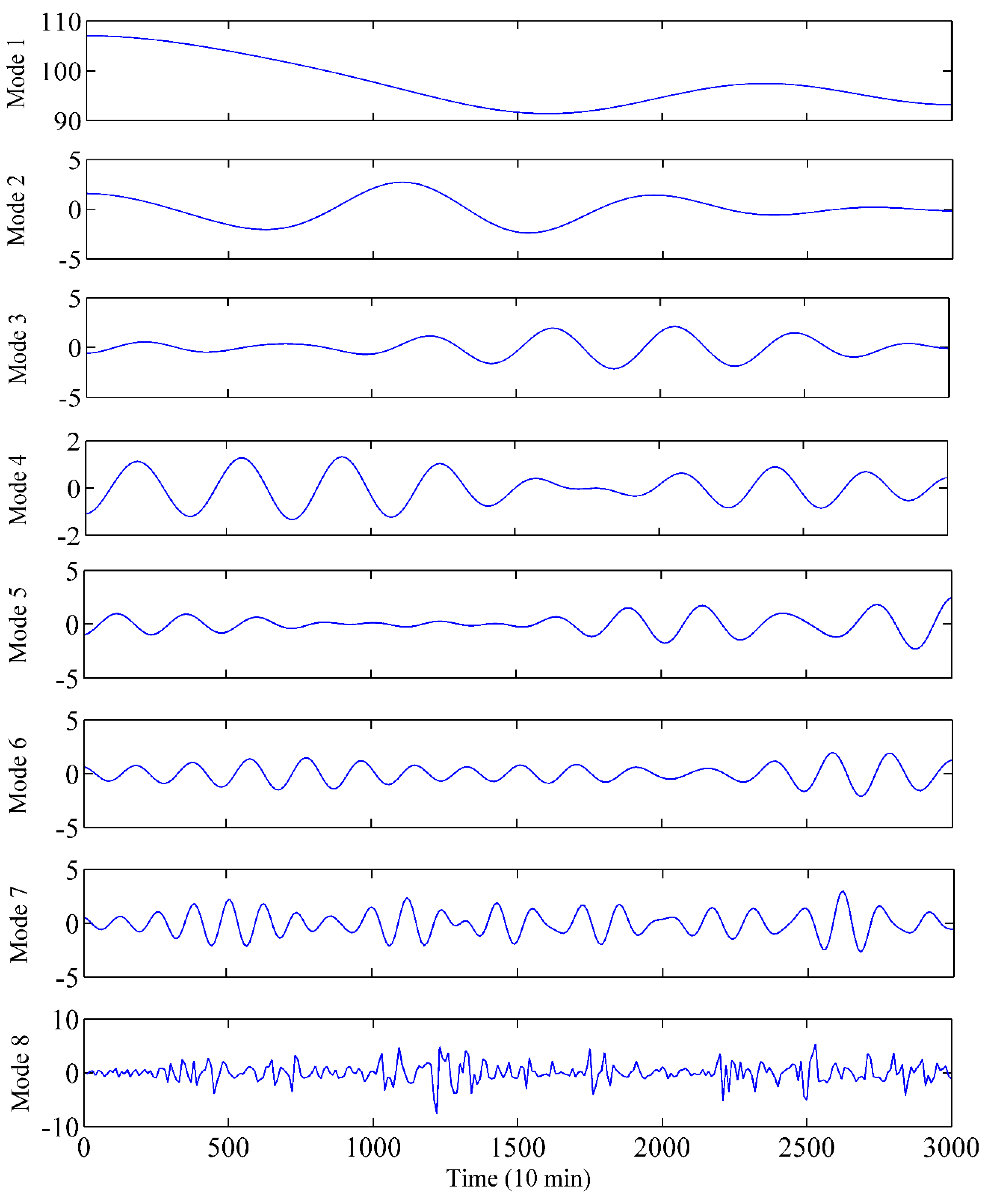
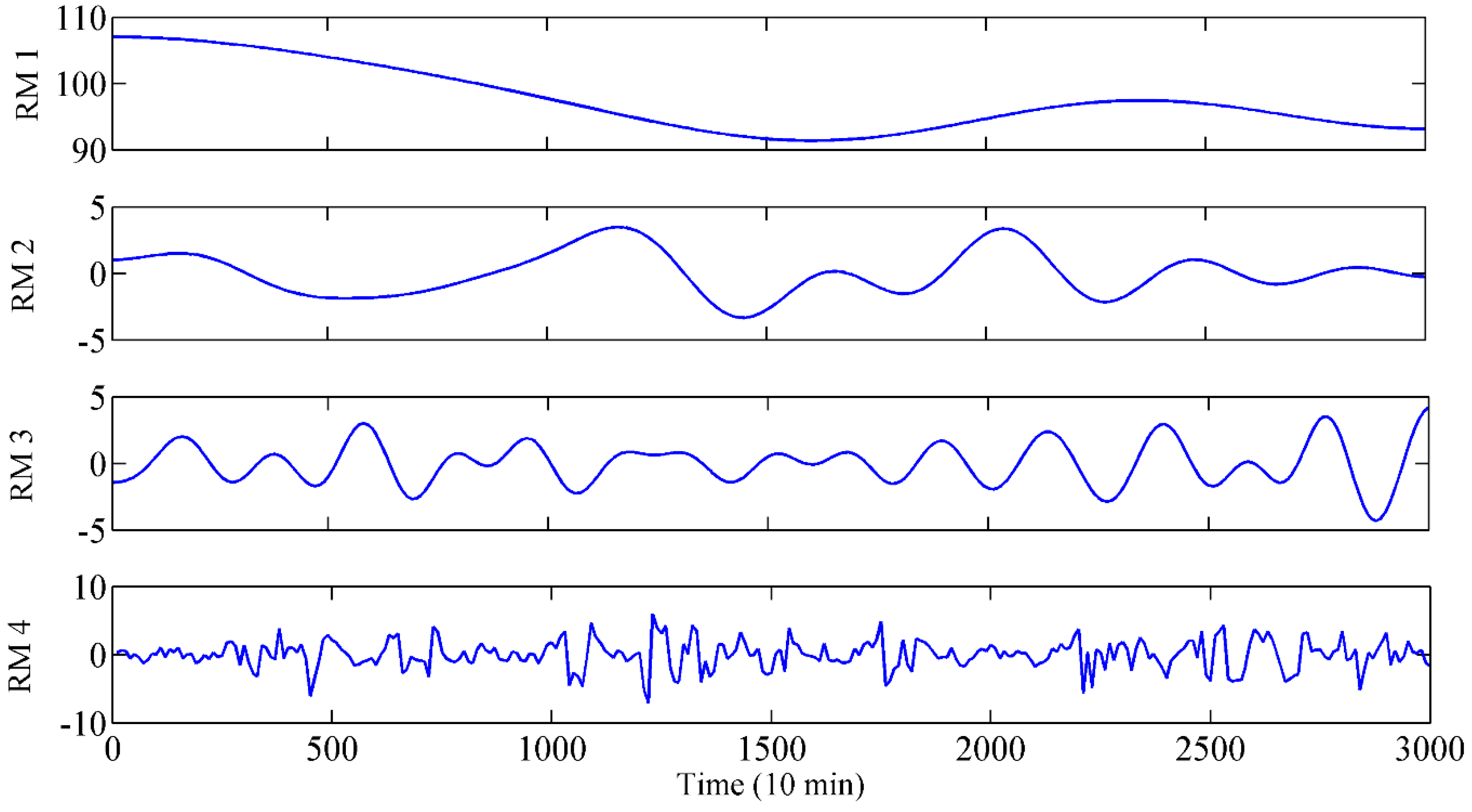

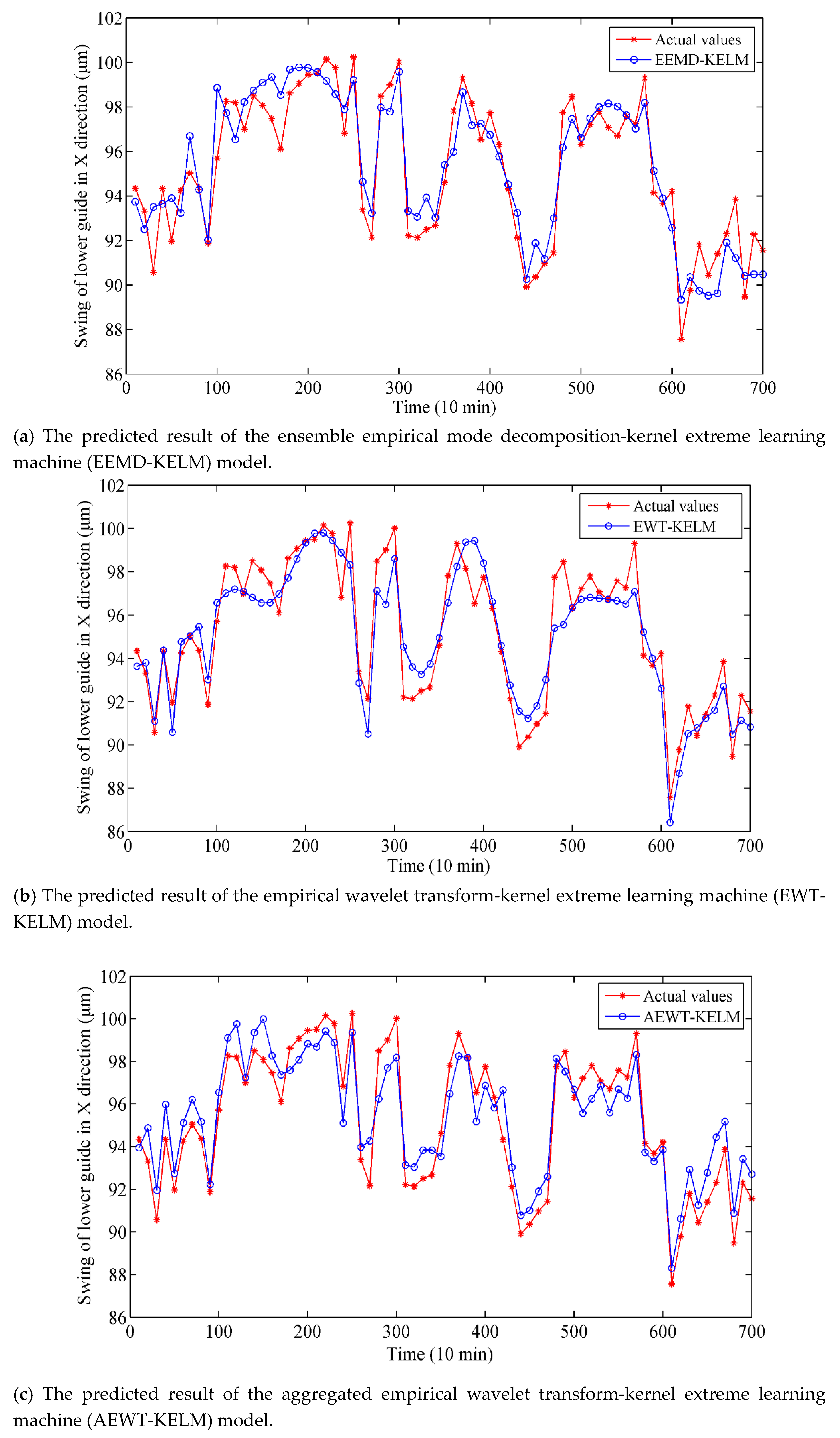
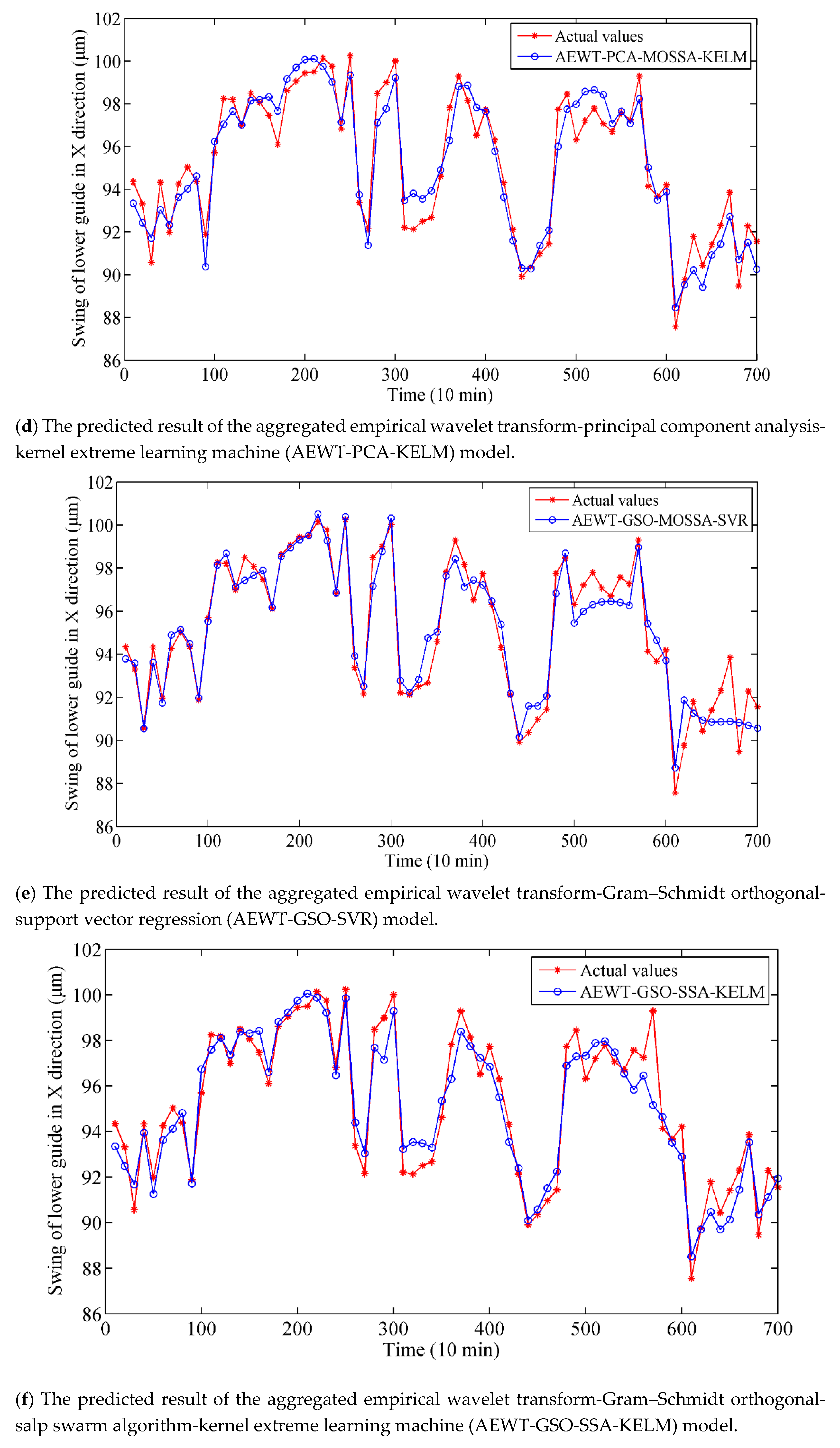
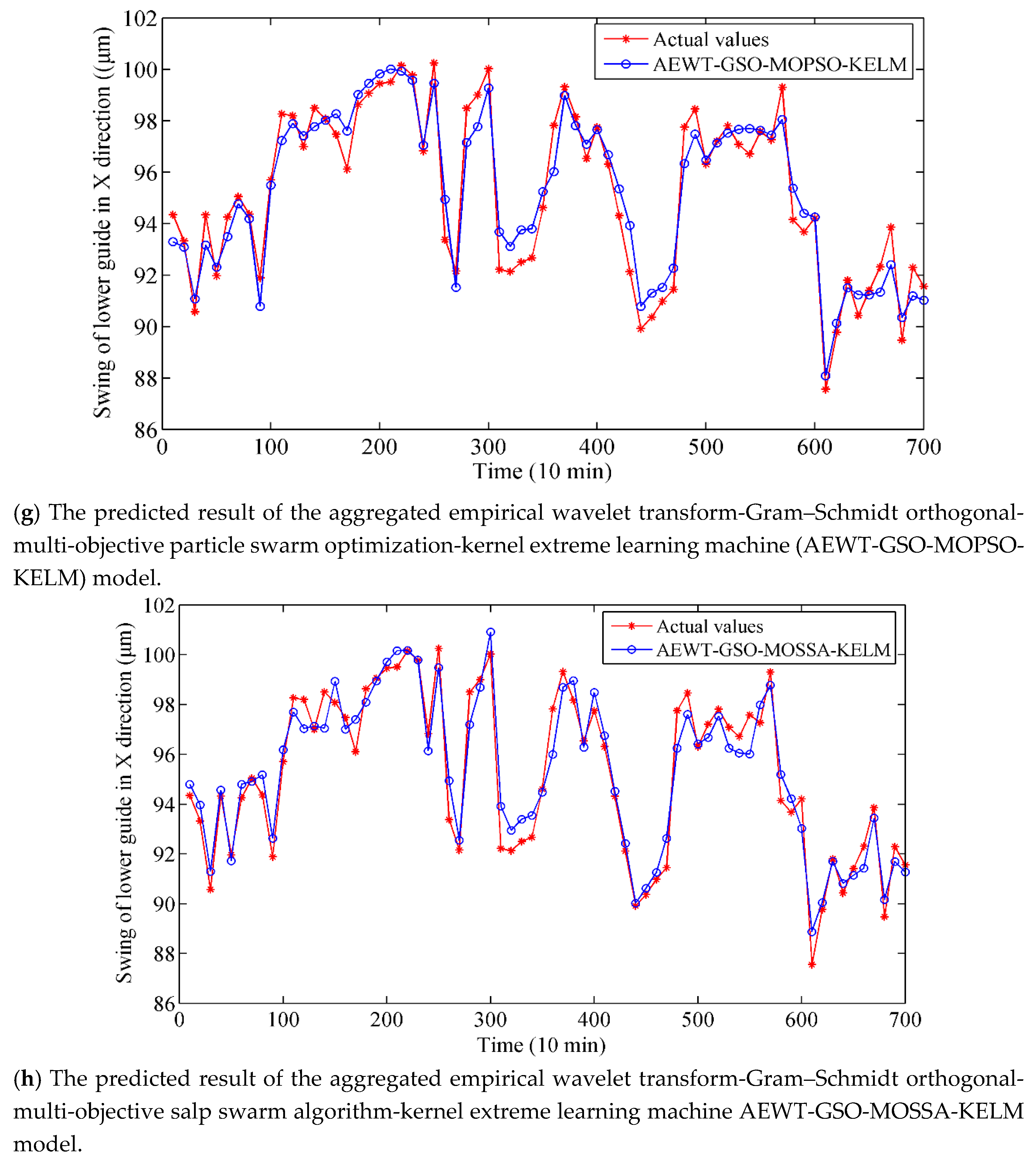

| Forecasting Models | Methods | Data Set | Authors | Reference |
|---|---|---|---|---|
| Statistical models | Autoregressive moving average (ARMA) method | The low methane compressor | Pham et al. | [10] |
| Grey prediction method | Rolling bearing vibration | Xia et al. | [8] | |
| Artificial intelligence (AI) models | Artificial neural network (ANN) | The gear transmission vibration of pellet mills | Milovancevic et al. | [11] |
| Support Vector Regression | The vibration trend of hydro-turbine generating unit | Fu et al. | [12] | |
| Extreme learning machines | The vibration data of cutting tools and bearing | Javed et al. | [13] | |
| Long short-term memory recurrent neural networks | The vibration of turbine engine | El Said et al. | [16] | |
| Hybrid models | LS-SVR and chaotic sine cosine algorithm optimization | Vibration trend of hydropower generator | Fu et al. | [4] |
| Empirical mode decomposition and relevance vector machine | The vibration signal of bearings | Fei S.-W. | [14] |
| Sensor | Time | Time Interval | The Number of Samples |
|---|---|---|---|
| BENTLY3300 | 24–27 July 2011 | 10 min | 300 |
| Indicator | Mode 1 | Mode 2 | Mode 3 | Mode 4 | Mode 5 | Mode 6 | Mode 7 | Mode 8 |
|---|---|---|---|---|---|---|---|---|
| SE | 0.0085 | 0.0381 | 0.0869 | 0.129 | 0.113 | 0.168 | 0.212 | 0.233 |
| RMs | Modes Contained | HS |
|---|---|---|
| 1 | Mode 1 | [0, 0.0085] |
| 2 | Mode 2, Mode 3, | [0.0308,0.0869] |
| 3 | Mode 4, Mode 5, Mode 6 | [0.112, 0.168] |
| 4 | Mode 7, Mode 8 | [0.177, 0.233] |
| Model | Precision of Model Prediction | Computing Time | |||
|---|---|---|---|---|---|
| RMSE (μm) | MAE (μm) | MAPE (%) | R | Time (s) | |
| EEMD-KELM | 1.236 | 1.031 | 1.093 | 0.827 | 106.730 |
| EWT-KELM | 1.207 | 0.997 | 1.053 | 0.874 | 105.138 |
| AEWT-KELM | 1.105 | 1.027 | 1.157 | 0.879 | 98.876 |
| AEWT-PCA-KELM | 0.919 | 0.798 | 0.846 | 0.902 | 100.263 |
| AEWT-GSO-MOSSA-SVR | 0.857 | 0.641 | 0.681 | 0.885 | 109.114 |
| AEWT-GSO-SSA-KELM | 0.939 | 0.743 | 0.791 | 0.906 | 95.716 |
| AEWT-GSO-MOPSO-KELM | 0.841 | 0.704 | 0.747 | 0.911 | 109.987 |
| AEWT-GSO-MOSSA-KELM | 0.823 | 0.650 | 0.682 | 0.913 | 102.920 |
© 2019 by the authors. Licensee MDPI, Basel, Switzerland. This article is an open access article distributed under the terms and conditions of the Creative Commons Attribution (CC BY) license (http://creativecommons.org/licenses/by/4.0/).
Share and Cite
Zhou, K.-B.; Zhang, J.-Y.; Shan, Y.; Ge, M.-F.; Ge, Z.-Y.; Cao, G.-N. A Hybrid Multi-Objective Optimization Model for Vibration Tendency Prediction of Hydropower Generators. Sensors 2019, 19, 2055. https://doi.org/10.3390/s19092055
Zhou K-B, Zhang J-Y, Shan Y, Ge M-F, Ge Z-Y, Cao G-N. A Hybrid Multi-Objective Optimization Model for Vibration Tendency Prediction of Hydropower Generators. Sensors. 2019; 19(9):2055. https://doi.org/10.3390/s19092055
Chicago/Turabian StyleZhou, Kai-Bo, Jian-Yu Zhang, Yahui Shan, Ming-Feng Ge, Zi-Yue Ge, and Guan-Nan Cao. 2019. "A Hybrid Multi-Objective Optimization Model for Vibration Tendency Prediction of Hydropower Generators" Sensors 19, no. 9: 2055. https://doi.org/10.3390/s19092055
APA StyleZhou, K.-B., Zhang, J.-Y., Shan, Y., Ge, M.-F., Ge, Z.-Y., & Cao, G.-N. (2019). A Hybrid Multi-Objective Optimization Model for Vibration Tendency Prediction of Hydropower Generators. Sensors, 19(9), 2055. https://doi.org/10.3390/s19092055





